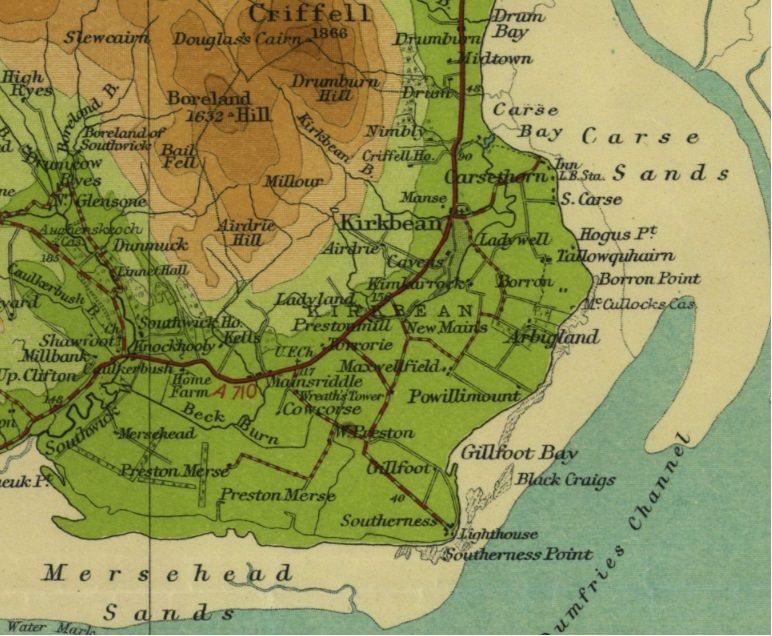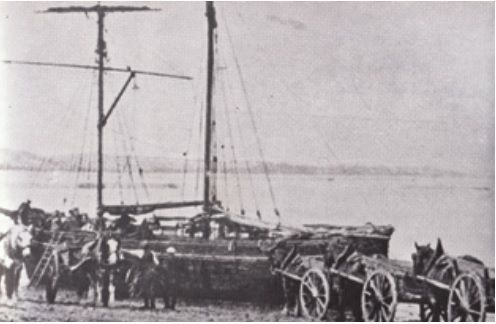
Parish History
Kirkbean Parish is one of the most beautiful in South West Scotland, situated, as it is, in a simple rural
valley. It comprises four main villages, Kirkbean, Carsethorn, Prestonmill and Southerness. The last of
these is predominantly a holiday complex, with the population in the summer increasing greatly
It is bounded on the northeast, east, south and southwest by the Solway Firth, comprising some ten
miles of sea coast and, on its northern extremity, by Criffel which rises to 1,870 feet and dominates the
view northward. Looking out across the Solway Firth, it is possible to clearly see the northwest coast of
England and the Isle of Man.
The church yard at Kirkbean has had all the monumental inscriptions transcribed and mapped and
indexed and these will be added to this website in due corse to assist those carrying out their family
history research.
Carsethorn village used to be a thriving fishing and coastal trading port, and was an important local port
serving Dumfries from the 16th century. With the first mention in 1562, when a ship was loading for
Rochelle and Bordeaux. The 'Carse', as it is fondly referred to, acted as an outport for Dumfries. With the
larger vessels going up river, with the aid of a pilot, on the high tide, to unload there. The smaller boats
unloading at the jetty, these were chiefly coastal journeys to ports either side of the Solway, to Ireland
and to the Isle of Man. After the jetty fell into disrepair, the sandy shore made it safe to beach ships to be
loaded and unloaded from carts at low tide, then float them off on the next rising tide. At a time when
roads inland were no more than rutted tracks, most freight and much passenger traffic was by sea,
something which would only change with the road improvements in the early 1800s.
Scotland's greatest export has not been its whisky, but its hard-working and ambitious people seeking a
better life in the New World. During the late 1700s and early 1800s, emigration to the American and
Australian Colonies reached high levels and newspaper advertisements show emigrant ships sailing
regularly from Carsethorn on the feeder ships to Liverpool.21,000 people emigrated from here in the 18th
century for a better life in the colonies. It is said that, in 1850, 10,000 people emigrated to North America,
7,000 to Australia and 4,000 to New Zealand through the 'Carse', leaving from the jetty which was
constructed in 1840 by the Nith Navigation Commission and used by the Liverpool Steam Packet
Company. The remains of that jetty still stand beside the deep-water channel at the north end of
Carsethorn; it was an L shaped structure of which the longest face allowed the steamers a good pierhead
to come alongside.

In 1775, the ''Lovely Nelly'', captained by William Sheridan, took 82 emigrants to Lot 59 on Prince
Edward Island, Canada. The reason for the families going was given as 'to get more bread' - in Scotland,
they were almost destitute.
A rather grimmer export trade also emerged with the transportation of convicts to Australia. They were
marched down from Dumfries and housed in the barracks at the river's edge. The whitewashed building
remains to the south of the bus-stop in Carsethorn to this day.
The coastal trade reached its peak in the late 1840s with almost 25,000 tons entering the river and
steamboats such as the ''Countess of Nithsdale'' maintained long established links with Liverpool.
During the 1870s and 1880s, the local Captain, John Robson, traded in the ''Defiance'' to Archangel for
timber, but this was in the face of a general decline. The coming of the railway in 1850, along with the
ongoing costs of the many improvements needed to the navigable channel, started a slow decline in the
seaborne trade and, by the early 1900s, very little trade was left.
